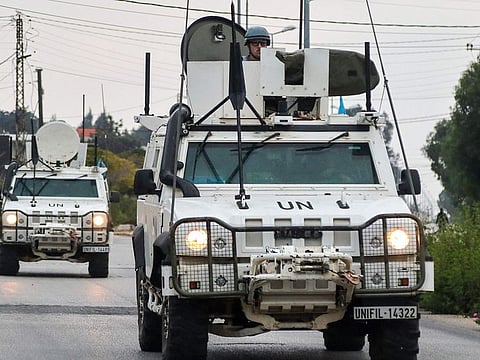Israel wants UNIFIL to move from harm’s way in Lebanon: What is UNIFIL? When was it created and Why?
Here is what you need to know about the UN Interim Force in Lebanon and its mission

On Thursday, two peacekeepers from the 10,000-strong United Nations Interim Force in Lebanon (UNIFIL) were injured when an Israeli tank shell struck an observation tower near the “Blue Line” separating Lebanon from Israel and the Golan Heights.
This incident occurred after Israel issued a warning for UNIFIL to relocate from areas it claimed were close to Hezbollah positions used for launching rockets into northern Israel, a request that UNIFIL declined.
On Sunday, Israeli Prime Minister Benjamin Netanyahu called on the UN chief to remove UN peacekeepers deployed in southern Lebanon out of “harm’s way”.
“Mr Secretary General, get the UNIFIL forces out of harm’s way. It should be done right now, immediately,” Netanyahu said in a video statement issued by his office. At least five UN peacekeepers have been wounded in recent days as Israeli forces fight against Hezbollah in southern Lebanon.
Here are a few facts about UNIFIL (United Nations Interim Force in Lebanon) and its mission:
When was it created and why?
Despite its name suggesting a temporary mission, UNIFIL has become one of the longest-serving peacekeeping operations in the world.
UNIFIL was established by the UN Security Council in 1978 following Israel’s invasion of Lebanon prompted by a deadly raid by Palestinian militants operating from Lebanon.
In 1982, Israel invaded Lebanon again, leading to a prolonged occupation that lasted until 2000.
Then in 2006, after a monthlong war between Israel and Hezbollah, a Shiite militant group whose political wing is a major force in Lebanon, UNIFIL was enlarged and its mandate expanded.
The force was tasked with helping Lebanon’s armed forces maintain a buffer between Israel and the so-called Blue Line at the Litani River, about 28km from the Israel-Lebanon border.
What is UNIFIL’s mandate in Lebanon?
UNIFIL mainly has an observational role. This includes patrols by foot and vehicles between the Blue Line and Litani River, as well as patrolling the area near the shoreline with their naval peacekeeping force called UNIFIL Maritime Task Force.
In case of violations of Resolution 1701, UNIFIL reports them to the UN Security Council.
“Whenever there is an incident across the Blue Line, UNIFIL immediately deploys additional troops to that location if needed to avoid a direct conflict between the two sides and to ensure that the situation is contained,” the peacekeepers describe their approach on the UNIFIL website.
They also liaise with the Lebanese army and the Israel military in order to deal with the situation without any escalation, they explain.
However, the peacekeepers are only allowed a gradual use of force for self-defence, under certain circumstances, and only to “ensure that its area of operations is not utilised for hostile activities.”
How do they operate in Lebanon?
The UN peacekeeping forces are deployed across 50 bases throughout 1,060 square kilometers that cover the area between the internationally-recognised border between Lebanon and Israel and Lebanon’s Litani River, some 30 kilometers north of the border.
UNIFIL’s headquarters is in the town of Naqoura.
Why has been UNIFIL under fire?
Israel and the United States believe UNIFIL has not been effective in preventing Hezbollah from operating and stockpiling weapons in southern Lebanon.
In 2018, a Hezbollah tunnel was detected that ran below the Blue Line into Israel.
Lebanon’s governments have repeatedly said UNIFIL failed to stop Israeli violations of Lebanon’s airspace.
Hezbollah leaders have accused UNIFIL of spying for Israel, and said its presence is violating Lebanon’s sovereignty.
Also, UNIFIL is rather costly. According to the United Nations General Assembly, UNIFIL was the UN’s fifth-largest peacekeeping force in 2023 with an annual cost of more than $550 million between July 2023 and July 2024.
Who makes up UNIFIL?
UNIFIL is made up of about 10,000 peacekeeping troops and other personnel from around 50 countries, mostly drawn from Indonesia, India, Ghana, Nepal, Italy, Malaysia, Spain, France, China and Ireland.
The UN peacekeeping website does not list the United States among them.
The largest contributors of troops are Indonesia, with 1,231 peacekeepers, and Italy with 1,068. The Netherlands and Uruguay have sent one person each.
Sign up for the Daily Briefing
Get the latest news and updates straight to your inbox



